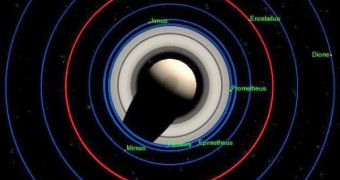Mounting evidence gathered by the Cassini space probe over the last few months seems to indicate the fact that there is certainly water underneath Enceladus' icy surfaces, NASA experts say. The geysers that erupt on the moon's surface daily throw water vapors and some organic-laced ice in the air, as demonstrated by the last set of picture the probe sent on its last approach to the celestial body.
"It's virtually impossible that we don't have liquid water some place in the body," says Carolyn Porco, the head of Cassini's imaging team at the Space Science Institute in Boulder, Colorado. She added that the space probe passed as close as 15.5 miles to the surface of the satellite, taking high resolution photos of what was going on below.
Based on the new images, NASA experts have already built a design of how Enceladus' interior structure looks like. Unlike Earth, where tectonic plates move in opposite directions and collide with each other, giving birth to earthquakes and tsunamis, on Saturn's moon everything goes one way, so most craters that blow ice and water from under its crust seal shut from time to time, while other open in places where the pressure under the mantle becomes too strong.
"We are not certain about the geological mechanisms that control the spreading. It's very unusual. You wouldn't find something like this on Earth," argues Cornell University scientist Paul Helfenstein, in New York.
"We are very excited and feel very fortunate to have stumbled upon such a fascinating place," Porco says, while adding that future Cassini passes on the moon will probably reveal more of its internal make-up, and will confirm or infirm hypotheses that say that there are under-the-crust tidal waves that force the geysers to erupt, as warmth coming from the gravitational force of Saturn heats up the water underneath.

 14 DAY TRIAL //
14 DAY TRIAL //